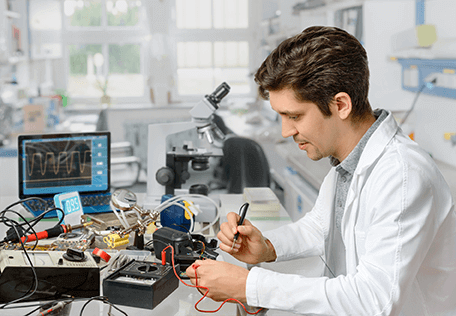联系我们
与泰克代表实时聊天。 工作时间:上午 9:00 - 下午 5:00(太平洋标准时间)。
致电我们
工作时间:上午9:00-下午5:00(太平洋标准时间)
下载
下载手册、产品技术资料、软件等:
反馈
What is calibration?
Calibration is the comparison of a measurement device (an unknown) against an equal or better standard. A standard in a measurement is considered the reference; it is the one in the comparison taken to be the more correct of the two. One calibrates to find out how far the unknown is from the standard.
Commercial calibration
A "typical" commercial calibration references a manufacturer's calibration procedure and is performed with a reference standard at least four times more accurate than the instrument under test.
Why calibrate your instruments?
The calibration of instruments is all about confidence in your measurement results. Calibrating your instrument assures you that your measurements are accurate within the specification limits that led you to select the instrument in the first place. Routine calibrations are your prescription for the continued health and performance of your instrument.
How often should I calibrate my instrument
Several factors can influence your test equipment’s measurement accuracy and should be considered when evaluating and determining the calibration interval.
Questions to Consider:
- Does the end-use application or organizational quality program dictate a specific calibration interval?
- What is the historical reliability of the test instrument, or how often has the instrument been found out-of-tolerance during calibration?
- How often is the test instrument used?
- What is the required accuracy for your application?
- What are the environmental conditions (temperature, humidity, air quality, etc.) where the instrument is stored and used? What impact might those conditions have on instrument performance?
- What is the relative cost of calibration compared to the potential cost of a quality issue with your product or service?
Tektronix has the expertise and system tools to assist customers with calibration interval analysis that will enable you to manage your risk and reduce your overall cost of calibration.


How do I Implement or Improve a Calibration Program?
Any successful calibration program must begin with an accurate calibration schedule for your test, measurement and diagnostic equipment.
- The schedule should contain a unique identifier which can be used to track the instrument, the location, and the instrument’s custodian (Often asset management software, bar-coding systems, and physical inventories are used to help establish accurate calibration schedules).
- It is important when assembling a calibration schedule that modules, plug-ins, and small handheld tools are not overlooked. Also, you may have several “home-made” measuring devices (e.g. Test Fixtures) which will also need to be captured on your equipment list for a reliable calibration program.
- The next step is to identify all of the instruments on your schedule that may not require calibration due to redundancies in your testing process (Tektronix can help you identify these instruments).
- After creating an accurate calibration schedule, procedures must be established for adding new instruments, removing old or disposed instruments, or making changes in instrument custodianship. Reports should be run with sufficient time for both the end user and the service provider to have the unit calibrated with a minimal impact on production.
- A late report identifying any units about to expire or already expired will ensure 100% conformity. A full service calibration laboratory will supply these recall reports and will provide special escalation reporting when equipment is not returned for service.
CalWeb® enables you to easily manage asset pools and calibration programs. Basic access to CalWeb is provided when you choose Tektronix as your calibration service provider.
Featured Content
选择泰克,满足你所有的校准需求
为来自9000多家制造商的设备提供校准服务——远远不止泰克!



